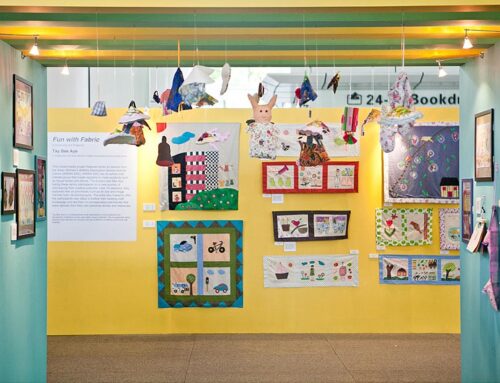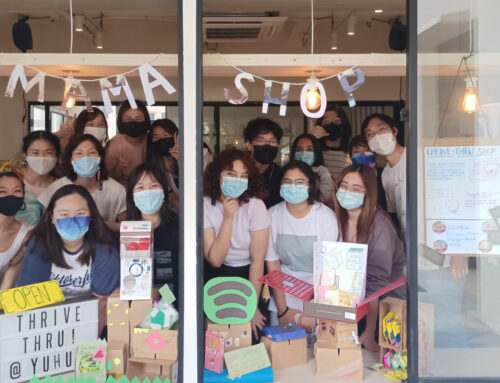Library / Field Studies
Assembling and Learning with Others
Library / Field Studies
Assembling and Learning with Others
By Regina De Rozario
2 August 2024
The work of community-building often foregrounds the importance of converging on shared purpose, goals, and values. However, it is also important to recognise that diverse viewpoints and strengths are just as crucial to the process of developing resilient groups and arriving at novel perspectives. How might artists and groups engage with the notion of diversity intentionally and meaningfully in community development projects? Guest contributor Regina De Rozario reflects on this with examples from the inaugural ArtsWok Learning Forum. This is the second article of a two-part series.
Gathering, Cohering, Diverging
Ways of gathering, being, and learning together often begin with the notion of commonality. One finds or joins a group or community by seeking others with shared interests or similar goals. Historically, community building and community-based learning and development have been closely intertwined even before Singapore’s independence. Community centres, since the late 1940s, served not only as neighbourhood gathering spaces but also as hubs for sharing skills, knowledge, intergenerational learning, and cross-cultural exchange.1 Over time, these community spaces played an important role in fostering social cohesion and a sense of national identity.2
Today, spaces for communities exist as physical and virtual sites. Some groups form on the premise of a shared aspect of identity and lived experience, such as their location or cultural background. While others may assemble because of a particular cause that they believe in, or specific needs that they want to address together. Regardless of the reason one begins with, the propensity to remain in a group or community tends to rely on other factors, such as one’s ability to participate, contribute, and to be seen and heard by others in the group.3 Apart from this, there is the group or community’s ability to engage with its members meaningfully; and to provide them with opportunities to learn, grow, and lead together.
In the broadest sense, a group is said to be cooperative, functional, or effective when it is able to set, commit, and achieve its goals, as well as build and maintain a sense of respect and camaraderie in spite of differences that exist in the group. Conversely, a group could be regarded as less optimally functional or less effective when its purpose and plans are not discernible by its members; when the work of participating and organising is unevenly distributed; when differences and conflicts are not acknowledged; or when members feel that their contributions or abilities are unrecognised.4
I was thinking about these notions of assembling and cohering as I attended the second day of the ArtsWok Learning Forum, held at the Goodman Arts Centre on 29-30 March 2024. In particular, I wondered if it was possible for an entity as diverse as a community to cohere. If so, what aspects of diversity should a group or community pay attention to, and what are the processes involved to foreground these aspects? Furthermore, how might one ensure that aspects of the community’s diversity are still recognised and valued, and not flattened through acts of top-down consensus-building?
One of the segments at the Learning Forum provided a relevant response to the question of how diverse perspectives could be recognised and harnessed. Dubbed “Unconference,” the segment enabled attendees to propose and post their own topics to the forum’s online message board, as well as vote on these proposed topics. The six topics that received the most votes were then accorded breakout spaces for attendees to gather and converse. As a principle, those who suggested the topics were expected to facilitate their respective conversations, but this was largely kept open to the groups and they could direct themselves in whatever way they chose. The segment straddled both days of the forum, with breakout conversations conducted on the first day, and consolidated findings from these conversations presented to all of the forum attendees at the start of the second day.
While the concept of “unconferencing” is not exactly new5, the open and flexible nature of the format added a lively buzz to the forum’s overall proceedings. There was a sense of active and democratic participation, and an emphasis on commitment. Through these, one is encouraged to “show up” to have a say and to shape the discourse. Because the groups were expected to be self-facilitated, attendees had to exercise a level of risk-taking, push through their own personal vulnerabilities and assumptions, and decide for themselves how best to unpack the topic and engage with each other.
This approach of giving over to attendees and regarding them as experts and facilitators of their own areas of inquiry may seem simple and obvious. However, as someone who often participates in academic conferences and delivers public workshops herself, I found the format a refreshing change from what is usually a carefully calibrated process of assembling and working in groups. Instead of worrying about how such an approach might introduce conflict and discomfort amongst participants — and it will inadvertently be uncomfortable for some — the forum organisers chose to lean into ambiguity and trust.

The unconference segment of the Learning Forum enabled attendees to propose, facilitate, and participate in small-group discussions on topics of their choice. These self-facilitated discussions were scheduled for the latter part of the forum’s first day, and the discussion findings were presented to all forum attendees on the morning of the following day (above). Photo by Zinkie Aw.
This tactic of “intentionally diverging” can create interesting resonances as well as frictions for groups. For instance, one group that discussed the very topic of uncertainty and “sitting with the unknown” when working with communities, recognised that definitions of “what makes a community” might differ for community members themselves. They also candidly acknowledged that working with communities would entail dealing with their own feelings of vulnerability and exclusion, as well as coming to terms with the fact that community members may not want their help.
The question of sitting with dynamic and shifting outcomes came up in another group’s perspectives on key performance indicators (KPIs) within arts-based community work. Apart from recognising that goals and KPIs had to be discussed and agreed upon with community stakeholders, they found that it was just as crucial for practitioners to be clear about what the community did not need. This would enable them to make informed decisions about what to set aside, give up, or scale back. The group also raised a question about the link between project goals and one’s ego, self-worth, and identity as a practitioner. This seemed resonant with the points made by the earlier group: What could (or should) a practitioner do in response to contributions that are rejected or declined by a community? The takeaway here is that changing particular goals and performance indicators is sometimes necessary, for as long as the community’s perspective is foregrounded. Reframing or scaling back goals does not necessarily mean a process or practitioner has failed. Rather, practitioners need to understand that there will always be shifting and uncertain dynamics between community members that they would need to attune to. In this sense, the work of arts-based community development must afford to stay agile and flexible. As such, practitioners need to be open to certain divergences — even if it means disrupting their own habits of practice — and be able to guide community members along these new paths where needed.
The notion of embracing both ambiguity and agility also resonated within a third group’s presentation. Here, a question was raised about working with communities that were not tied to specific physical locations. On the one hand, having a specific location lends a sense of familiarity, safety, and routine to community activities. That said, given how space in Singapore is a challenging and costly resource to procure, and is often made available on a temporary or conditional basis, the group wanted to see if it was possible to reframe this centrality of fixed physical spaces in their work. For communities without a specific shared location, they suggested clarifying the purpose of communing, and building a “space” from there. They cited interest spaces, issue spaces, and identity spaces as examples of communities that could be developed, untethered by a fixed location. Importantly, approaches to “build” and develop such spaces would need to be welcoming, inclusive, mutually supportive, and cognisant to the differences and power dynamics that could unfold therein. Through their sharing, I sensed the beginnings of a typology that could speak to the unique challenges and conditions of assembling in Singapore.
In all, I found the unconference presentations provoked much speculative thought and imagination. Judging from the myriad of points that were shared, this approach of encouraging attendees to take the reins and make detours proved to be quite fruitful — especially in terms of uncovering tangents and perspectives that could be developed into future discussions, workshops, or even research projects.
Learning, Unlearning, Relearning
The notion of listening to and learning from diverse perspectives continued through to the formal panel discussion of the day. Entitled Learning, Unlearning and Relearning: Development Pathways for Community-Engaged Practitioners, the panel focused on the lessons that have emerged from their respective community-based projects and practices.
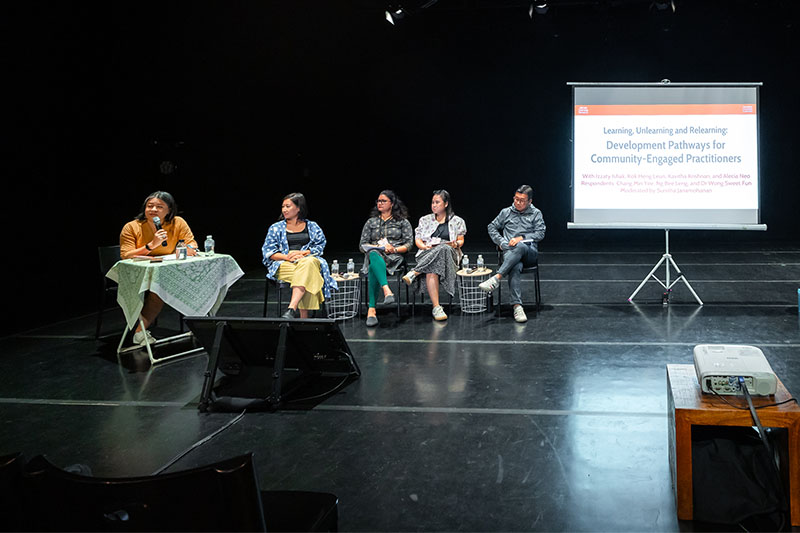
The second panel of the ArtsWok Learning Forum discussed development pathways for community-engaged practitioners. The panel was moderated by Sunitha Janamohanan (left), featured presentations by practitioners Alecia Neo, Kavitha Krishnan, Izzaty Ishak, and Kok Heng Leun (second from left to right). Photo by Zinkie Aw.
Alecia Neo, an artist and cultural worker, shared about her work with Brack, a Singapore-based art collective that she co-founded. Its work is largely focused on gathering and engaging in dialogue with socially engaged artists in Southeast Asia. In addition to critically examining what it means for practitioners to gather, relate, and engage with each other’s shared aspects and differences, Brack’s interdisciplinary and participatory activities serve as a generative platform for collective imagining. She also shared about her work with Unseen Art, an arts initiative that she runs and that is co-led by visually impaired individuals. I was particularly taken by Alecia’s take on artistic practice as a means of reframing possible positions that an artist or art collective can occupy, not just to lead a project, but to support a community’s ambitions and needs. Further, artists can — through the speculative impetus of their practice — help to dream and develop possible alternative pathways and futures of doing, living, and being. For Alecia, the ongoing questions of practice tend to be “What else can art do? What else can art be?” These appear as simple lines of inquiry on the surface, but they seem to run deep and far. Asked reflexively, these questions carve out space to pause and engage in divergent modes of observation, thought, and action.
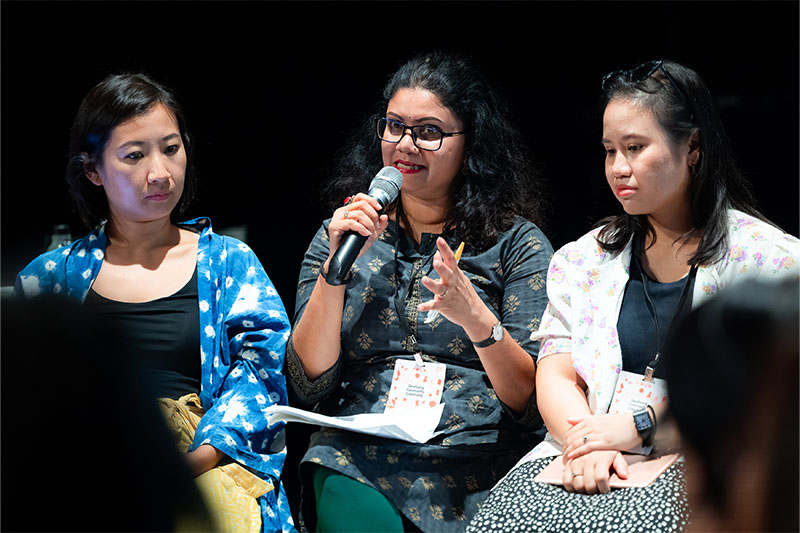
Alecia Neo, Kavitha Krishnan, and Izzaty Ishak (left to right). Within each of the presentations emerged a shared attentiveness toward the diverse needs and strengths of community participants, and how these could be surfaced through deep listening and conversations. Photo by Zinkie Aw.
In a similar vein, Kavitha Krishnan’s interest in communities and social issues is foregrounded throughout her practice. Apart from co-founding Maya Dance Theatre (MDT), Kavitha leveraged on her training as an occupational therapist to establish the Diverse Abilities Dance Collective (DADC) with six founding members with Down Syndrome. The initiative, a division within MDT, enables persons with different abilities to engage with professional performers. Apart from dancing together and organising performances and workshops, members of the collective develop skills related to employment in the arts, such as costume management, administration, and preschool teaching. From listening to Kavitha’s sharing, I saw the work of DADC as a way of diversifying how dance could be taught and practised. Mediated through performers with different abilities, DADC’s approach demonstrates an alternative example of excellence in dance. What I understood as key to her process was the importance of volition and habituations. That is, to pay attention to the personal drives, motivations, and routine demonstrations of each member of the collective. In a sense, this is a reminder to recognise a collective as a “whole,” but also as a gathering of “parts”— with each of these “parts” being a unique individual with needs, motivations, habits, and valuable perspectives.
To the question of how practitioners might situate themselves within a community to engage in modes of mutual and reciprocal learning, Izzaty Ishak pointed to the power of storytelling and making space for members to share their narratives. As a community development practitioner within the social service sector, Izzaty observed the importance of investing in relationships both within and beyond an identified community. Apart from working closely with members of the community who would actively participate in her facilitated programmes, she would also try to reach out to its extended network of parents and caregivers. The point here was to make it easy for anyone to contribute and show their support for community initiatives, even if it means contributing their perspective on a situation or issue. Here, I recognised how the process of constant dialogue is crucial for both the practitioner and the community. By having conversations and encouraging individual members to talk and learn from each other, practitioners are able to decentre themselves. That is, to remind themselves that their place within this work is not to be a voice of authority, nor to “teach” or “lead” the community. Rather, as facilitators, they are there to encourage shared accountability, while remaining mindful about development objectives.

Kok Heng Leun illustrating how audiences would gather and assemble themselves for performances sited in public space. Photo by Zinkie Aw.
Relatedly, on the subject of how community dynamics may be shaped and facilitated, was a sharing by theatre practitioner and educator, Kok Heng Leun. As founder and artistic director of Drama Box, Heng Leun played a pivotal role when Drama Box co-presented Both Sides, Now with ArtsWok Collaborative between 2013 and 2022. In sharing his experience of staging various projects in public space, Heng Leun pointed to how the term “community” would need to be considered differently when its participants are gathered through a public space activity. This resonated with my own understanding of how a “public” is constituted of many disparate communities organised along visible and less visible lines. For example, there may be individuals who identify with more than one community; as well as individuals who do not feel like they belong to any group. In this light, an artistic intervention in public space, such as a durational performance, could create a form of temporary community as well. In turn, this community engages in a shared moment of spectating, listening, conversing, and responding. At the same time, within this large public assembly, individuals also create their own “space” for their individual sense-making and learning. It follows then that to work with public space is to be acutely aware of its layers, and the possible ways members of the public may engage individually and flow in groups. Also, to understand how an artistic intervention might affect and be affected by these diverse layers assembling, overlapping, and colliding with each other.
From Consensus to Learning from Dissensus
In addition to the insights shared by the four practitioners, the session also featured respondents from the education, social service, and health sectors. They were Chang Mei Yee, an applied drama educator and practitioner; Ng Bee Leng, divisional director of strategy and transformation at Allkin Singapore; and Dr Wong Sweet Fun, clinical director for population health and community transformation at Khoo Teck Puat Hospital and Yishun Health. Amidst their respective sharings, the respondents collectively recognised how artistic modalities could enable different groups of various expertise and experiences to build a shared language, and from there, a shared understanding of each other. Art, as noted by Dr Wong, is invitational. It expands, makes space, lets others in, and calls you to be present in an embodied, multisensory way.
Several points stood out to me as I reflected on the day’s sharings and returned to the questions I had at the start — Is it possible for a group, community, or even a public to cohere given the diversities that would be inevitably present? To this, I say “yes,” even if this cohesiveness is apparent only for short periods of time. Perhaps the point here is to cohere by deciding jointly how to blend a sense of task effectiveness with social reciprocity and cooperation; or to eschew pragmatism with courageous risk-taking where needed to enact the change that is desired.
Given this, what aspects of diversity should a group or community pay attention to, and what are the processes involved to foreground these aspects? Threaded through each of the presentations was an implicit sense of care and concern between practitioners and the groups they facilitate. By this I mean a sense of care for project outcomes; the processes of artistic practice and learning that they were engaged in; as well as concern for each other’s well-being and safety. Conversations and deep listening were consistently referred to in many of the sharings. This makes sense as giving space for each other’s narratives is a crucial step towards building a shared language and understanding about needs, desires, and boundaries. Other processes included decentring and stepping aside to support others who are in a better position to decide on a given situation. Further, to discern when not to facilitate a group towards consensus. Instead, to embrace instances of dissensus and conflict even when this is discomfiting. That is, to value these as situations where one can learn about a situation from members’ own perspectives.
Helping to build a thriving and sustainable community that embraces diversity requires continuous reflexivity, clear and open communication, and a commitment to courageous risk-taking where needed. Finding common ground is just one part of the work. Fostering candid dialogue and sitting with diverse perspectives can help practitioners to clarify where their help is needed, and conversely, where it is not. It is through taking divergent and sometimes less pragmatic paths that one can learn, grow, and create a community that values difference as a part of its shared humanity.
[1] ’60 Years of Community Centres’ [24 March 2013, updated 15 September 2023]. RememberSingapore.org. ⌃
[2] Ng Kwee Choo, ‘Community Centres and Local Leaders in Singapore’, in Community Development Journal, Vol. 4, Issue 2 (Oxford: Oxford University Press, 1969), pp. 99-105. ⌃
[3] Christopher Gorse, et al., ‘Meetings: Factors that Affect Group Interaction and Performance’, in Procs 22nd Annual ARCOM Conference, ed. by D. Boyd (Birmingham, UK: ARCOM, 2006), pp. 915-923. ⌃
[4] Judith Stein, ‘Using the Stages of Team Development’, in MIT Human Resources. (Cambridge, MA: MIT University, n.d.).⌃
[5] Aidan Budd et al., ‘Ten Simple Rules for Organizing an Unconference’, in PLOS Computational Biology, Vol. 11, Issue 1. (San Francisco, CA: PLOS, 2015).⌃
Cover image: ArtsWok Learning Forum participants in discussion at a workshop. Photo by Zinkie Aw.
All images provided by ArtsWok Collaborative unless specified otherwise.
About Regina De Rozario
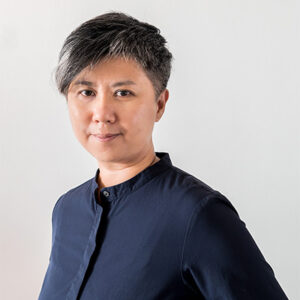
Regina is an artist, writer, and researcher investigating artistic practices in Singapore’s public spaces. A recipient of the National Arts Council Arts Scholarship for postgraduate studies, she is currently conducting her doctoral research at the National Institute of Education, Nanyang Technological University. She is also co-founder of Perception3, an interdisciplinary art duo based in Singapore. Their recent work includes commissioned installations for the Singapore Biennale (2016), iLight Singapore: Bicentennial Edition (2019), and the Singapore Night Festival (2022). As an adjunct educator, Regina is a supervisor with LASALLE College of the Arts’ MA Fine Arts programme, and a lecturer with the Nanyang Academy of Fine Arts’ BA (Hons) Fine Art programme where she teaches collective artistic practice and research methods.




